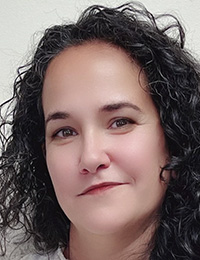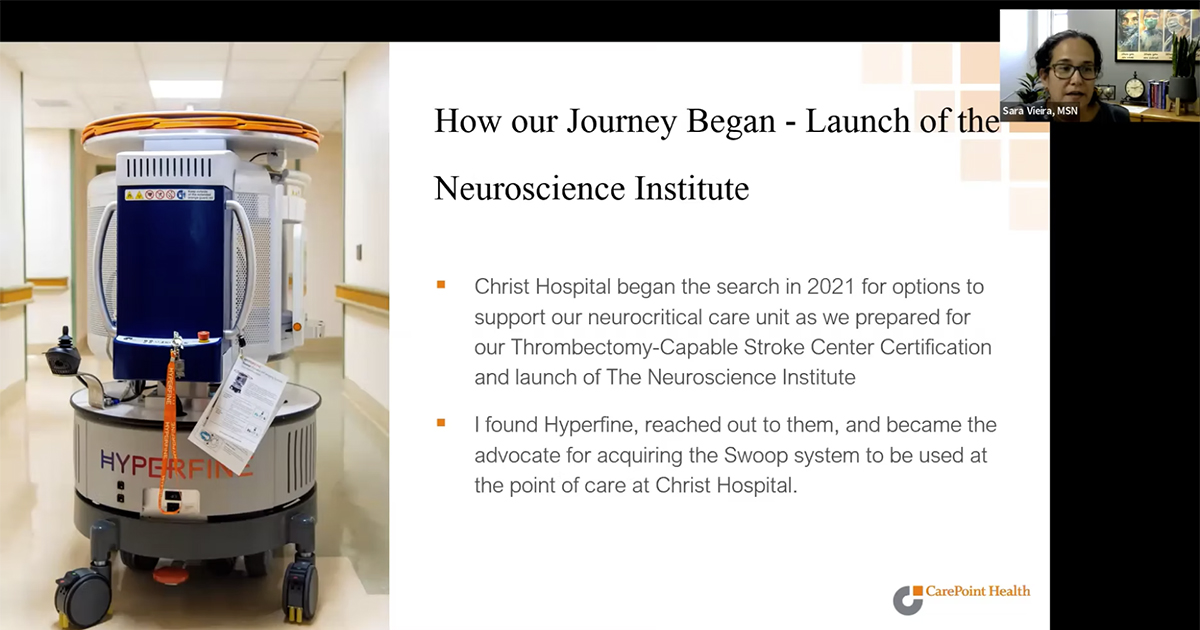Implementing Point-of-Care MR Imaging™ in the ICU of a Community-based Hospital
Watch Now See All Webinars GET NOTIFICATIONS
Sara Vieira, MSN
We are here with Sara Vieira, MSN, Vice President of Patient Care and Chief Nursing Officer at CarePoint Health Christ Hospital.
Hyperfine: Sara, your hospital is in Jersey City, one of the most populated cities in New Jersey. In 2021, Christ Hospital began looking for a solution to support becoming a Certified Thrombectomy Center with a dedicated network Neuroscience Institute at Christ Hospital. You told us earlier that to become a Certified Thrombectomy Center, the hospital needed access to imaging 24 hours a day, seven days a week. What options did Christ Hospital have for neuroimaging in 2021?
Sara: We had a mobile MRI trailer in our parking lot that was initially supposed to be a temporary solution, but it had become a permanent part of our facility connected by an enclosed walkway. We only had access to this MRI from 7:00 AM–3:30 PM, and only non-ventilated patients were able to access the system. If a patient can walk, they must navigate a set of stairs to get to the mobile MRI trailer. Otherwise, we raise them into the trailer on a lift gate (while still in bed). Our only option for ventilated patients was to transfer them to another hospital via an ambulance able to accommodate a ventilator.
Hyperfine: What kind of challenges did this pose for your hospital teams?
Sara: This arrangement posed several challenges for us. The first was preparation time for the patient to ensure clinicians can safely move them. Second, for patients able to make the journey to the mobile MRI trailer, our system is not staffed 24/7, so we could only get an MR for them from 7 AM–3:30 PM. Additionally, if the patient required transport to another hospital, it required staff members from the unit to accompany them and ensure they were stable during the trip. Having an ICU staff member away from the unit increases the stress on the other clinicians.
Hyperfine: What caused you to explore looking for an alternative solution?
Sara: We began looking for expanded MRI access when we started down the Certified Thrombectomy Center path. During this time, we realized that adding a capacity using a traditional high-field MRI would still have the challenge of impacting the quality of care for our ICU patients by potentially creating a nursing shortage when patients required imaging in the mobile MRI trailer or at another hospital. I contacted Hyperfine to see if the Swoop system would meet our needs. Our thrombectomy center project team, which included our neuroscience director, our interventional radiologist, and our radiology team, evaluated the Swoop system, and we started our portable MRI program in July of this year.
Hyperfine: Once we delivered your Swoop system, how long did it take you to get up and running, and what advice can you share with others?
Sara: After a 2-week training program with hospital staff, we identified a process that significantly minimized the number of patients requiring transport from the ICU. Since implementation, we have identified a person responsible for bringing the Swoop system to the patient’s room in the ICU while the staff prepares the patient and the room for a scan. We also created specific Swoop orders in our PACS system and have seen a considerable change in the quality of care for our neurocritical care patients.
Instead of a three-hour round trip to another hospital or the time-consuming workflow involved in moving the patient to the mobile MRI trailer, we bring the Swoop system directly to the patient’s bedside. Once a clinician enters the order, the staff prepares the room while a dedicated tech moves the Swoop system into position for a scan which can take anywhere from 30–40 minutes. The total time from preparation to scan completion is less than 60 minutes, and the patient never has to leave the room.
For our CarePoint Health Christ Hospital ICU team, there is now zero time away from the unit, and all ICU patients receive continuous care. It’s been a game changer for this hospital, with a solution that enabled us to continue providing high-quality care without the high cost or risk to patients.
The most important advice I could give to other teams implementing a Swoop MRI system is to take a team approach. Involve your nursing leadership and identify ways to perform steps in parallel and streamline your workflow.
Click here to listen to the entire webinar with Sara Vieira and Dr. Daniel Korya of Christ Hospital. Or, we invite you to learn more about the benefits of the Hyperfine Swoop Portable MR Imaging System™.
Disclosure: Hyperfine provided Christ Hospital, Dr. Daniel Korya, and Sara Vieira, MSN, compensation for this webinar.
